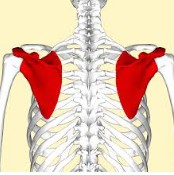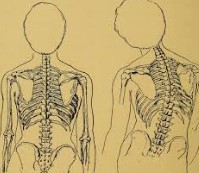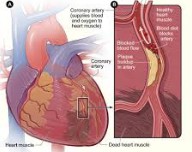People that complain about shoulder blade pain are likely to experience discomfort throughout the upper abdominal area as well as the backside of the chest. Over 60 million people in America suffer from back pain and it is specifically the upper back pain that disrupts the lives of most sufferers.
Shoulder blades are also referred to as scapula and are 2 triangle-shaped bones found at the top of the back. The scapula is connected to the upper arm bone known as the humerus and the collar bone known as the clavicle as well as the muscles of the arms, neck, and upper arms.
Interscapular pain or pain between the shoulder blades can be caused by many different factors. The symptom is typically due to something minor such as muscle strain. However, it could be a sign of something more serious such as lung cancer or a heart attack.
Symptoms of Shoulder Blade Pain
The cause of the shoulder pain determines the symptoms you experience. The pain you can be burning, temporary, chronic, sudden, appearing in different parts of the shoulder, and radiating from one area to the next. Shoulder blade pain can lead to tingling or numbness, and can become worse when breathing or lying on the shoulder. Crepitus is another symptom of shoulder pain. It is a grating sound when you press or move the shoulder.
Causes of Shoulder Blade Pain
It is important to take the structures in a particular area into consideration when thinking about pain in any region of the body.
Structures between the Shoulder Blades include:
- Skin
- Muscles: Muscles in the area between the shoulder blades include the lower and middle trapezius muscles and the rhomboids.
- A portion of the lungs
- Part of the heart
- Part of the esophagus
- The thoracic aorta
- The thoracic spine
Pain occurring between the shoulder blades may originate in any of the structures or may occur some distance from the region because of how nerves transmit pain signals. It is important to remember that pain between the shoulder blades has different causes. In some instances, there will be pain in various regions. The pain you are experiencing might dissipate after a while but you should not ignore some of the causes of pain between the shoulder blades.
15 Common Causes of Pain Between the Shoulder Blades
Aging
As humans age, the density of the bones reduces, which leads to increased brittleness. Osteoporosis can make the bones more susceptible to injuries or more brittle. In such an instance, even a minor fall is enough to cause pain in 
Flu or Colds
What are some of the first symptoms you exhibit if you have a flu or cold? You might notice that you might be experiencing pain between the shoulder blades because you could be developing flu or cold symptoms. The discomfort you might be experiencing will later develop into a runny nose.
Improper Posture
You may experience pain between the shoulder blades due to many different reasons and improper posture is one of the main ones. Improper posture can be attributed to the fact that you may have been driving for a long time or you could have poor posture as a result of working for a long time without changing positions.
Compressed Nerve
Compressed nerve can cause a type of pain you have never imagined you would ever experience. It is a type of pain that may originate from one side of the back then seemingly move towards the arm.
Herniated Disc
If you are not very familiar with herniated disc, it simply refers to a slip disc. It usually happens in case there is a breakdown of the pad between the spine. You may have a herniated disc due to many different reasons, but it is usually a result of medical conditions or accidents in most cases.
Gallbladder Problem
If you are experiencing a type of pain that radiates in the middle of the back while you are experiencing pain in the upper abdomen at the same time, you could be experiencing problems with your gallbladder. It is important to always keep in mind that problems with the gallbladder can be of two types – it could be the inflammation of the gallbladder or it could be gallbladder stones. It is important to be aware of exactly what is causing your problem.
Frozen Shoulder
If you do not know about the condition known as frozen shoulder, you might mistakenly believe that it is a joke. However, this is not the case at all. Frozen shoulder is usually brought about by the lack of synovial fluid on the shoulder. You typically know that you are suffering from frozen shoulder if you are experiencing a type of pain that worsens every time you make a movement.
Fracture
In some instances, you might not actually know that you may have fractured some parts of your back. You might have been involved in an accident that may have cause some of the bones in your body to crack. You can know that you have a fracture if you are experiencing a type of pain that radiates throughout the back.
Spinal Stenosis
Spinal Stenosis is a condition that many people might not be aware of but it refers to a condition that involves the narrowing of the canal. The spinal canal may narrow in any part of the spine. The people that usually suffer from the condition might start feeling pain on the middle portion of their back and their legs might start feeling numb at the same time.
Heart Attack
In some cases, people may experience pain in the middle part of their backs due to an impending heart attack. In certain instances, the person may be already experiencing the heart attack but is not actually aware of it.
Osteoarthritis
Osteoarthritis is a condition whereby you might be experiencing a type of pain in the middle part of the back usually in the morning as well as at night. It is actually a condition of the joint in the middle portion of the back.
Bulging or Herniated Discs
The referred pain to this region can be due to degenerative disc disease in the thoracic and cervical spine. It is actually quite common for people with disc disease in their neck to experience pain only in other areas, which can cause delays in diagnosis. Other symptoms may include tingling, numbness, or pain in either one or both arms. In some cases, the pain attributable to disc disease is positional. For instance, it could worsen or get better if you extend or flex your neck.
Developing Liver Diseases
Liver cancer, abscesses, or other liver diseases can lead to pain underneath the right shoulder. If liver cancer has spread, it could be the culprit. Liver abscess tends to eat part of the liver leaving a gaping hole, which is responsible for the pain. The pain will then move up to your shoulder.
Cancer
Lung Cancer, and in particular Pancoast tumors can push on nerves near the top of the lungs thus causing referred pain between the shoulder bones. Other types of cancer that can trigger pain in the area include mesothelioma, esophageal cancer, liver cancer, and lymphomas. Cancers that spread to the neck bones such as breast cancer can equally trigger pain between the shoulder blades without any other symptoms sometimes.
Acid Reflux
Referred pain in the back in the region between the shoulder blades could be due to Gastroesophageal Reflux Disease (GERD). GERD symptoms may also include difficulty swallowing, hoarseness, and chest pain. Untreated GERD can not only cause discomfort, but it is associated with the later emergence of esophageal cancer. Pancreatic inflammation can also cause similar type of pain because of the irritation to the underside of the diaphragm.
Preventive Measures
The Right Diet
The way you eat and the type of food you consume has an effect on your health. However, what is of importance in preventive stages will have to do with moderating your daily food intake. This means you are able to eat any type of food that you like, but remember that to eat in moderation.
Exercise
Regular exercise can assist you in developing back strength as well as reinforcing joints in the spine, which keeps the intervertebral discs in check. Exercise also helps the body to use protein and fats which is derived from the food you consume, which avoids the development or onset of osteoarthritis.
Diagnosis and Treatment of Shoulder Blade Pain
In most cases, pain experienced in the shoulders will subside within a day or two. However, when this pain persists, most doctors will recommend an examination. This may include imaging tests or an MRI to assess what is happening inside the shoulder. Dependent on the issue, medical interventions may be an option. However, there are home treatments and remedies that may still work. Here are some of the effective types you can try:
Avoid Any Activities and Rest
In many cases all that your body really needs to deal with pain will be rest to allow this area to heal. When the pain you are experiencing was caused by a muscle injury or repetitive motion, resting and allowing your body to heal will bring about much relief. You can also make use of cold or heat packs to speed up the healing time.
Maintain the Correct Posture
The incorrect posture can result in unnecessary pain and aches. If you have an issue with maintaining the correct posture, ensure that you keep your spine as straight as possible. Posture is also associated with sleeping the “correct way”. Make sure the pillow you sleep with is keeping your shoulders and head aligned.
Use Scapular Retraction Exercises
The correct exercises are able to assist you in effectively overcoming discomfort and assist you in the process of healing. The majority of exercises involve stretching the painful area that assists in flexibility.
Massaging Techniques
Massage can provide outstanding relief for most issues that involve muscle pain which is inclusive of scapular pain. Consult with a chiropractor or physical therapist to make sure you are focusing on the correct areas. The majority of individuals achieve significant relief after one to two massage sessions.
Medication
Medications from over-the-counter can assist in decreasing pain in regards to scapular injuries. For pain that is more intense stronger medications like steroids and muscle relaxants are prescribed by physicians.
Home Remedies for Relief from Shoulder Blade Pain
Similar to how there are often a variety of different reasons for lower back pain or upper back pains, there are also numerous ways involved to treat shoulder pain. In certain cases, pain may become unbearable and painkillers may be a temporary option. However, it is important to keep in mind that using painkillers only mask the issue instead of addressing the problem.
You can achieve impressive results with relief from a painful shoulder blade from home. For example, you can use upper back stretches that you should do every morning as you get out of bed and again before you go to bed at night. Your physiotherapist or chiropractor will be able to guide you and teach which stretches are ideal for upper back or shoulder blade pain. It is also extremely helpful to attend organized classes where you are guided through all the different exercises and participate with other people that are suffering with the same or similar pain.
In some cases the application of cold or hot treatments can also relieve pain. For example taking a hot-bath is a great method to heat up the area. Other methods include using your hot-water bottle around the area that is painful to ease away the pain. At the same time cold packs are also effective in relieving persistent or burning pain. Some people often find that alternating between cold and hot treatments is also a great way to relieve pain.
Changing the way you sleep can also decrease the strain you are experiencing in your upper back and in some cases can assist in easing the degree of pain you are in. Your physiotherapist or chiropractor can advise you on the best position and how to make use of pillows to achieve results.
If you have been for a diagnosis and the pain you are experiencing is caused from muscle strain, which is common with many of the sports injuries, participating in physiotherapy is a really good option. Trained physiotherapists are able to guide their patients through stretches and exercises to the stage that the patient is able to carry on from home on their own.
Stretches to Use for Shoulder Blade Pain
Below are a few tips, exercises and stretches you can do to assist in relieving pain in your upper back or shoulder blades.
Improving Your Work Station
When sitting at your desk make sure your feet are positioned a foot apart on the floor and your knees are also bent preferably in a 90-degree angle. Your elbows should also be at a 90-degree angle and your back should be straight. Your computer monitor needs to be at your eye-level and the mouse needs to be positioned near to the keyboard.
Correcting Your Posture
Your ear, your shoulder and your hip joint need to align when you sit to achieve good posture. The shoulders must not slouch and keep your head up straight.
Massaging the Area
Use a massage ball by laying the painful shoulder onto the ball and roll back and forth over the ball by using your body weight.
Stretching the Shoulder Blades
Intertwining the fingers, lean your body back and then hunch the upper part of your body as far as you can possibly push it. Push the hands far away as you possible can and look down.
Stretching the Thoracic Spine
Use a foam-roller that you position under the shoulder and lie down. Keep the ribs downwards, while avoiding arching the back. Your hands should be behind the head for support. Roll very slowly and gently over the roller.
After you have completed these exercises, use heat packs to assist in relaxing the muscles even further.
Alternate Remedies for Upper Back and Shoulder Pain Relief
Acupuncture
This treatment was first developed in China and involves puncturing the tissues or skin with very small needles to relieve the pain. The professionals that use acupuncture have a belief system that the energy force known as “Chi” in the human body becomes blocked which is what results in pain. Acupuncture is focused on freeing up the “Chi” meridians in the way of inserting needles into pressure points which releases the pain. It is also believed that these needles release a neurochemical that assist in healing processes.
When Should You Consult a Doctor?
You need to consult a doctor if the back pain persists longer than 2 weeks with home treatment.
If you experience any of the following, see a doctor immediately:
- Pain that worsens or pain that you are unable to manage at home
- Painful urination, or other urinary tract infection symptoms
- New or increased back pain with fever
- New weakness in the legs or weakness that worsens
- New numbness in the legs or numbness that worsens
- New loss of bowel or bladder control
Call 911 immediately if:
- The back pain coincides with chest pain or other heart attack related symptoms such as pressure, nausea or vomiting, shortness of breath, uneven or fast heartbeat, feeling lightheaded or dizzy, or a strange feeling in the upper belly, jaw, neck, back, or one or both arms or shoulders.
- You experience signs of severe injury to your spine after a fall, such as severe neck or back pain, the inability to move part of your body, weakness or tingling in the belly, chest, legs, or arms.
Conclusion
The information provided here sums up just about all you should know about back pain between shoulder blades. To determine the most appropriate cause of action, proper evaluation is required. The important thing to remember is that you should always take back pain seriously. It could be a sign of something that potentially causes irreversible damage to your body. Before you make any assumption, you should seek the opinion of a qualified medical professional. Proper, early diagnosis is critical to recovery.







